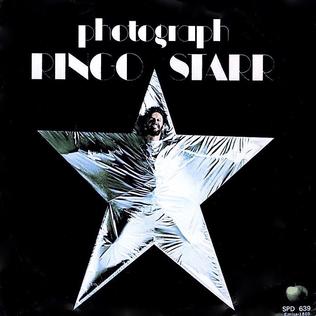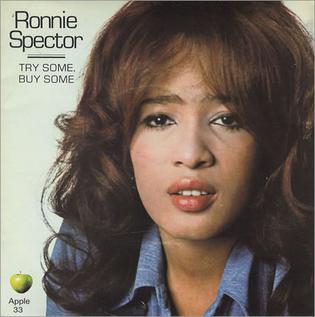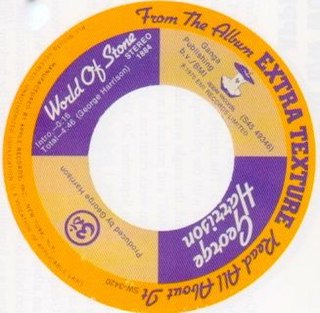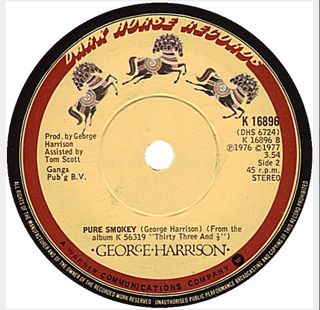
Extra Texture (Read All About It) is the sixth studio album by English musician George Harrison, released on 22 September 1975. It was Harrison's final album under his contract with Apple Records and EMI, and the last studio album issued by Apple. The release came nine months after his troubled 1974 North American tour with Ravi Shankar and the poorly received Dark Horse album.

"Photograph" is a song by English rock musician Ringo Starr that was released as the lead single from his 1973 album Ringo. Starr co-wrote it with George Harrison, his former bandmate from the Beatles. Although they collaborated on other songs, it is the only one officially credited to the pair. A signature tune for Starr as a solo artist, "Photograph" was an international hit, topping singles charts in the United States, Canada and Australia, and receiving gold disc certification for US sales of 1 million. Music critics have similarly received the song favourably; Stephen Thomas Erlewine of AllMusic considers it to be "among the very best post-Beatles songs by any of the Fab Four".

"Try Some, Buy Some" is a song written by English rock musician George Harrison that was first released in April 1971 as a single by American singer Ronnie Spector, formerly the lead vocalist of the Ronettes. She recorded it in London along with other Harrison compositions for a planned comeback album on the Beatles' Apple record label. The project was co-produced by Phil Spector, Ronnie's husband at the time, but abandoned following recording sessions that were hampered by his erratic behaviour. The only official release from the sessions, the single achieved minimal commercial success, peaking at number 77 on the US Billboard Hot 100 and number 63 on Canada's RPM Top 100. Harrison later added his own vocal onto a new mix of the instrumental track and included the song on his 1973 album Living in the Material World.

"Ding Dong, Ding Dong" is a song by English rock musician George Harrison, written as a New Year's Eve singalong and released in December 1974 on his album Dark Horse. It was the album's lead single in Britain and some other European countries, and the second single, after "Dark Horse", in North America. A large-scale production, the song incorporates aspects of Phil Spector's Wall of Sound technique, particularly his Christmas recordings from 1963. In addition, some Harrison biographers view "Ding Dong" as an attempt to emulate the success of two glam rock anthems from the 1973–74 holiday season: "Merry Xmas Everybody" by Slade, and Wizzard's "I Wish It Could Be Christmas Everyday". The song became only a minor hit in Britain and the United States, although it was a top-twenty hit elsewhere in the world.

"This Guitar (Can't Keep from Crying)" is a song by English rock musician George Harrison, released on his 1975 studio album Extra Texture (Read All About It). Harrison wrote the song as a sequel to his popular Beatles composition "While My Guitar Gently Weeps", in response to the personal criticism he had received during and after his 1974 North American tour with Ravi Shankar, particularly from Rolling Stone magazine. An edit of "This Guitar" was issued as a single in December 1975, as the final release by Apple Records in its original incarnation. The single failed to chart in either the United States or Britain.
"Don't Let Me Wait Too Long" is a song by English rock musician George Harrison, released on his 1973 album Living in the Material World. It was scheduled to be issued as a single in September that year, as the follow-up to "Give Me Love ", but the release was cancelled. Music critics have traditionally viewed "Don't Let Me Wait Too Long" as a highlight of the Material World album, praising its pop qualities and production, with some considering the song worthy of hit status.
"That Is All" is a song by English musician George Harrison released as the final track of his 1973 album Living in the Material World. A slow, heavily orchestrated ballad, it is one of many Harrison love songs that appear to be directed at either a woman or a deity. Harrison wrote and recorded the song during the height of his public devotion to Hinduism; on release, Rolling Stone described its lyrics as "a sort of Hindu In Paradisium".

"World of Stone" is a song by English rock musician George Harrison, released in 1975 on Extra Texture , his final album for Apple Records. It was also issued as the B-side of the album's lead single, "You". Harrison wrote the song in 1973 but recorded it two years later, following the unfavourable critical reception afforded his 1974 North American tour with Ravi Shankar and the Dark Horse album. Due to its context on release, commentators view "World of Stone" as a plea from Harrison for tolerance from these detractors. According to some of his biographers, the lyrics reflect Harrison's doubts regarding his devotion to a spiritual path – an apparent crisis of faith that followed his often-unwelcome spiritual pronouncements during the tour, and which permeated his work throughout 1975.

"Let It Down" is a song by English musician George Harrison, released on his 1970 triple album All Things Must Pass. The recording was co-produced by Phil Spector and employs the latter's Wall of Sound production technique to lavish effect. Its brash opening and choruses contrast with the ethereal quality of the verses – a loud/soft approach that has been credited with influencing indie bands during the 1980s and 1990s.
"Hear Me Lord" is a song by English rock musician George Harrison from his 1970 triple album All Things Must Pass. It was the last track on side four of the original LP format and is generally viewed as the closing song on the album, disc three being the largely instrumental Apple Jam. Harrison wrote "Hear Me Lord" in January 1969 while still a member of the Beatles, who rehearsed it briefly at Twickenham Film Studios that month, but passed it over for inclusion on what became their final album, Let It Be.

"Māya Love" is a song by English musician George Harrison, released on his 1974 album Dark Horse. The song originated as a slide guitar tune, to which Harrison later added lyrics relating to the illusory nature of love – maya being a Sanskrit term for "illusion", or "that which is not". Harrison's biographers consider the lyrical theme to be reflective of his failed marriage to Pattie Boyd, who left him for his friend Eric Clapton shortly before the words were written. Harrison recorded the song at his home, Friar Park, on the eve of his North American tour with Ravi Shankar, which took place in November and December 1974. The recording features Harrison's slide guitar extensively and contributions from four musicians who formed the nucleus of his tour band: Billy Preston, Tom Scott, Willie Weeks and Andy Newmark. Reviewers note the track as an example of its parent album's more diverse musical genres, namely funk and rhythm and blues, compared with the more traditional rock orientation of Harrison's earlier solo work.
"The Answer's at the End" is a song by English rock musician George Harrison, released in 1975 on his final album for Apple Records, Extra Texture . Part of the song lyrics came from a wall inscription at Harrison's nineteenth-century home, Friar Park, a legacy of the property's original owner, Sir Frank Crisp. This aphorism, beginning "Scan not a friend with a microscopic glass", had resonated with Harrison since he bought Friar Park in 1970, and it was a quote he often used when discussing his difficult relationship with his former Beatles bandmate Paul McCartney.
"Ooh Baby (You Know That I Love You)" is a song by English musician George Harrison, released in 1975 on his album Extra Texture (Read All About It). Harrison wrote the composition as a tribute to American singer Smokey Robinson, whom he often identified as one of his favourite vocalists and songwriters. The song was intended as a companion piece to Robinson's 1965 hit with the Miracles, "Ooo Baby Baby", and its inclusion on Extra Texture contributed to that album's standing as Harrison's soul music album. His impersonation of Robinson's celebrated vocal style on the track, including portions sung in falsetto, contrasted with Harrison's hoarse, laryngitis-marred singing on his 1974 North American tour and the poorly received Dark Horse album.
"Can't Stop Thinking About You" is a song by English musician George Harrison, released in 1975 on his final album for Apple Records, Extra Texture . A love song in the style of a soul/R&B ballad, it was written by Harrison in December 1973, towards the end of his marriage to Pattie Boyd and while he was having an affair with Maureen Starkey, the wife of his former Beatles bandmate Ringo Starr. Having first considered the song for his 1974 release Dark Horse, Harrison recorded "Can't Stop Thinking About You" in Los Angeles in May 1975 for his so-called "soul album", Extra Texture. Some authors view its inclusion on the latter release as an obvious attempt by Harrison to commercialise the album, in response to the harsh critical reception afforded Dark Horse and his 1974 North American tour.
"Grey Cloudy Lies" is a song by English rock musician George Harrison from his 1975 album Extra Texture . Harrison wrote it in 1973 during a period that he characterised as his "naughty" years, coinciding with the failure of his marriage to Pattie Boyd and his divergence from the ascetic path of his Hindu-aligned faith. He returned to the song two years later when filled with despondency and self-doubt in response to the scathing reviews that his 1974 North American tour with Ravi Shankar and Dark Horse album had received from several music critics.
"His Name Is Legs (Ladies and Gentlemen)" is a song by English rock musician George Harrison, released in 1975 as the closing track of his album Extra Texture (Read All About It). The song is a tribute to "Legs" Larry Smith, the drummer with the 1960s satirical-comedy group the Bonzo Dog Doo-Dah Band and one of many comedians with whom Harrison began associating during the 1970s. Smith appears on the recording, delivering a spoken monologue, while Harrison's lyrics similarly reflect the comedian's penchant for zany wordplay. The song serves as a precursor to Harrison's work with Monty Python members Eric Idle and Michael Palin, including his production of the troupe's 1975 single "The Lumberjack Song" and films such as Life of Brian (1979) that he produced under the aegis of his company HandMade Films.

"Pure Smokey" is a song by English musician George Harrison, released in 1976 on his debut album for Dark Horse Records, Thirty Three & 1/3. The song was the second of Harrison's musical tributes to American soul singer Smokey Robinson, following "Ooh Baby " in 1975. Harrison frequently cited Robinson as one of his favourite vocalists and songwriters, and Robinson's group the Miracles had similarly influenced the Beatles during the 1960s. In the lyrics to "Pure Smokey", Harrison gives thanks for the gift of Robinson's music, while making a statement regarding the importance of expressing appreciation and gratitude, rather than forgetting to do so and later regretting it. The song title came from the name of Robinson's 1974 album Pure Smokey.
"You and Me (Babe)" is a song by English musician Ringo Starr, released as the final track on his 1973 album Ringo. Starr's fellow ex-Beatle George Harrison wrote the song along with Mal Evans, the Beatles' longtime aide and a personal assistant to Starr during the making of Ringo. The track serves as a farewell from Starr to his audience in the manner of a show-closing finale, by lyrically referring to the completion of the album. During the extended fadeout, Starr delivers a spoken message in which he thanks the musicians and studio personnel who helped with the recording of Ringo – among them, Harrison, John Lennon and Paul McCartney, and his producer, Richard Perry.
"I'll Still Love You" is a song written by English rock musician George Harrison and first released in 1976 by his former Beatles bandmate Ringo Starr. Produced by Arif Mardin, the track appeared on Starr's debut album for Atlantic Records and Polydor, Ringo's Rotogravure. The composition had a long recording history before then, having been written in 1970 as "Whenever", after which it was copyrighted with the title "When Every Song Is Sung".

"I Don't Care Anymore" is a song by English musician George Harrison, released as the B-side of the lead single from his 1974 album Dark Horse. The A-side was "Dark Horse" in the majority of countries internationally and "Ding Dong, Ding Dong" elsewhere, including the United Kingdom. It is one of Harrison's relatively rare compositions in the country music genre and, equally unusual among his 1970s releases, the recording is a solo performance.











